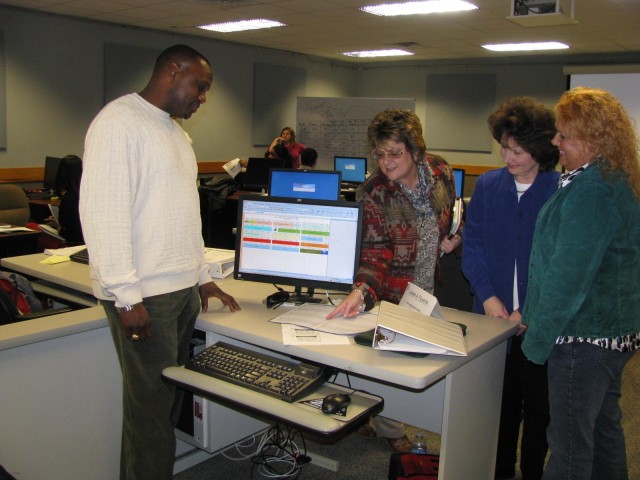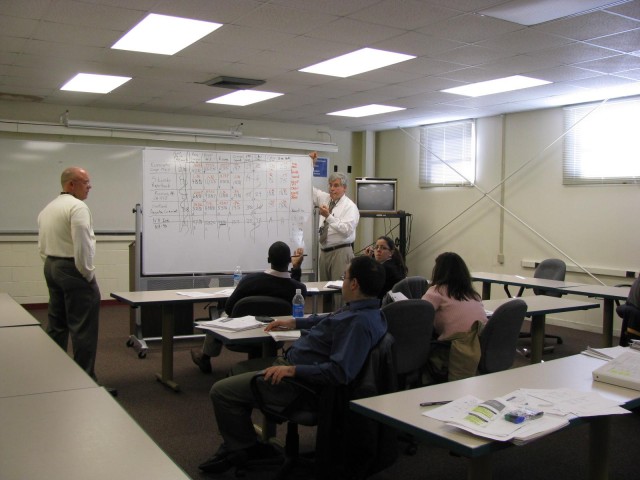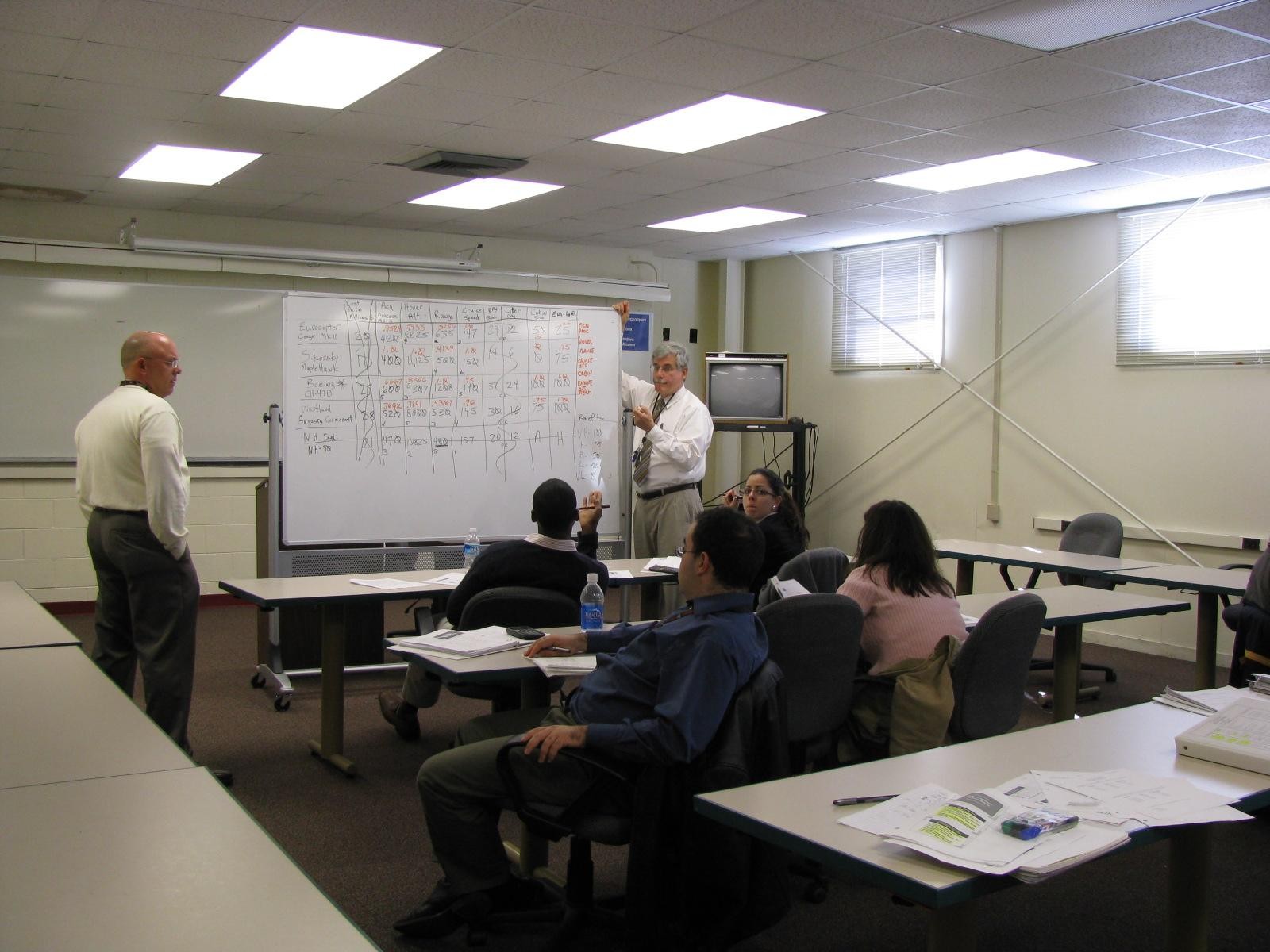The AMCOM Integrated Materiel Management Center is leading the pack in adapting unused office space on Redstone Arsenal to meet present and future employment needs thanks to a group of its employees working with the center's intern program.
Their accomplishment - transforming rooms in buildings 3340 and 3341 into classroom space for the IMMC intern training program -- is ushering in a trend Arsenal-wide involving various organizations interested in new and innovative ways to expand their facilities without new construction. As the Arsenal's OMEMS moves to its new headquarters at Fort Lee, Va., and other Army organizations shift their footprint due to BRAC realignments, empty buildings could represent much-needed expansion opportunities for expanding or new Arsenal organizations.
For IMMC, the transformation of a classroom in building 3340 and a breakout room in building 3341 on Little John Road will save the organization money, and make it easier to recruit and train interns.
"We were wrestling with how do we get more interns through training and how do we make it more cost effective for us," said Bill Andrews, deputy director for IMMC.
"In the course of those discussions, it was suggested we bring a couple of instructors here instead of sending 25 interns to Fort Lee."
Traditionally, IMMC interns in supply and maintenance career fields must undergo a 15-week training course known as the Intern Logistics Studies Program offered through the Army Logistics Management College at Fort Lee.
"This training is essential," said Richard Burton, chief of the Programs and Personnel Division in IMMC's Business Management Office.
"We are growing these young people to take part in our organization and be of service. We hire them straight out of college, we bring them into government service through this program and we give them the training they need to allow them to function in these career fields."
IMMC at Redstone Arsenal sends between 25 and 50 interns for training to Fort Lee every year, and incurs the costs of transportation, housing, per diem expenses and other incidentals due to the training requirement.
"At any given time, we have 100 interns on staff in our two-year intern program. We hired 40 some interns each year for the past two years," said Janine Wright, IMMC intern coordinator.
A cost analysis indicated that IMMC could save $12,500 per intern by providing training at Redstone Arsenal rather than Fort Lee.
"Besides the money issue, we were also looking at factors that affected the interns, such as separation from their family. Basically, in many cases, the training at Fort Lee was a hardship on interns," Burton said.
Once senior management decided to pursue a program that provided intern training at Redstone Arsenal and ALMC agreed to provide instructors for the training, the job of locating and equipping classroom space was assigned to a team of IMMC employees that included Wright, Cindy Janes, Kathy White, Clarence Matthews and Tom Murphy.
"To make this work, we had to have a learning environment equivalent to Fort Lee," Andrews said. "The main thing is it had to be separate from the IMMC working environment because we don't want interns to be distracted with whatever work they've been doing in the office."
But finding classroom space was not easy.
"Convincing ALMC to provide us with instructors wasn't a problem because they are customer oriented," Wright said. "Six to nine months ago, we started calling around in Huntsville and on the Arsenal to find classroom space. It took awhile to find a building we could use. Space is at a premium."
Discussions with Garrison representatives and various organizations finally pinpointed the OMEMS buildings on Little John as possible candidates for the IMMC training classrooms.
Although the buildings turned out to be ideal for IMMC requirements, the rooms still needed a lot of work to get them equipped as classrooms for IMMC interns. Modifications to the facility's structure were needed to move columns and petitions to accommodate eight work stations.
The classrooms are similar to an office setting, and are equipped with desks, computers, telephones, white boards, copiers, printers, projectors, screens, podiums and office supplies so that interns can learn in an environment similar to the IMMC work environment, and address problems and issues in class that are similar to what they will face in the real IMMC environment.
"It definitely was a challenge to get these classrooms up and running," said Matthews, who oversaw the contractors doing the upgrades. "It was something I hadn't done before in my work, so it was challenging. We started with a blank slate and built from the ground up."
While the main classroom is in building 3340, another classroom that provides space for the class to break out into groups and work together on problem solving is in building 3341.
In the course of the classroom planning, the IMMC team had to reduce their initial target number of 50 interns per class due to classroom limitations.
"There was just nothing that was large enough to accommodate 50 students at one time," Wright said. "We had to downsize according to what was available, and that was a classroom for 25 students."
The only thing missing from the new classroom space is the more global perspective of IMMC that interns receive when undergoing instruction at Fort Lee, Andrews said.
"At Fort Lee, there is a peer group of interns in the class that are selected Armywide instead of just local," he said. "There is more diversity in the classroom at Fort Lee because the interns are coming from all over the U.S.
"For us at Redstone Arsenal, most of our recruitment is done in the Southeast and that's who will be in the classes offered here. While they may be losing some diversity with training here, they are learning and working with fellow interns, and these interns are employees we want to work for IMMC at Redstone Arsenal for a long, long time."
Burton said he appreciated the dedicated efforts of Wright, Janes, White, Murphy and Matthew to make the classrooms a reality.
"It required a multitude of efforts by a select group to get this done," he said. "It was a multi-team effort that relied on a whole host of players to integrate all the processes."
Currently, IMMC has made arrangements for one class to be offered at the Arsenal training facility this year and in fiscal 2010. By fiscal 2011, plans call for increasing the Arsenal class offering to twice a year.
"Cost savings will really hit home in fiscal year 2011," Andrews said.
This year's class of 23 students began Jan. 20 and ends with graduation May 1. Other interns hired during 2009 will have to travel to Fort Lee for training or wait until the 2010 class is offered at the Arsenal.
"ALMC could only provide instructors for one class this year and next year because their instructors are busy teaching other classes at Fort Lee also," Burton said.
Yet, that doesn't mean the IMMC classrooms will be left empty between training classes.
"Our intent is to utilize the classroom space throughout the year," Burton said. "It will be available through IMMC for conferences, meetings, other training and various activities."
Overall, the move to offering intern training at Redstone Arsenal should help in growing the IMMC intern program, Andrews said.
"We always lost a few recruits when we told them they would have to live at Fort Lee for four or five months for training," he said. "It hadn't ever stopped us from getting the number of recruits we wanted, but we just had to look a little harder. Now, with the job and training offered locally, accepting a job with IMMC won't be a hardship on any of our interns."




Social Sharing